T. V. RAMACHANDRA,
D. K. SUBRAMANIAN
Centre for Ecological Sciences,
Indian Institute of Science,
Bangalore, India
Energy Sources, 19:945-988,1997. Copyright 1997 Taylor & Francis
| CONTENTS | Abstract | ||
| Introduction | |||
| Objective | |||
| Methodology |
|||
| Ananlysis, Results & Discussions | |||
| Techno-Economic Analysis of Devices | |||
| Conclusion | |||
| Acknowledgments | |||
| References | |||
| Appendix |
Solar energy can meet a largevariety of the small-scale decentralized energyneeds of a region. The design of solar devices depends on the global and diffuse solar radiation data. Estimation of solar radiation for Uttara Kannada district is done on the basis of solar and other climatological data available at stations located at Karwar, Honnavar, Shirali, Mangalore, and Goa. A variety of empirical equations for estimating monthly global solar radiation exist in the solar energyliterature..The most commonly used empirical formula is the one that relates sunshine duration and global radiation, also referred to as Angstrom's equation. We have used this relationship to estimate global radiation based on 20 years of data at Mangalore and 25 years of data at Goa provided by the India Meteorological Department. It is seen that computed and measured values (actual values) of global radiation (GR) agree within the range of 2-5% for most months.
Data at Goa and Mangalore have been analyzed in order to improve accuracy and to establish the role of other climatological parameters, such as mean daily temperature, relative humidity, specific humidity, minimum and maximum temperature, and rainfalL Based on the R2 value and the least value of the standard error of the Y estimate, the empirical formula consisting of mean temperature, sunshine duration, and specific humidity is the best relationship to estimate GR with the available climatological information. The computed and estimated values are within the range +or- 5%. With this empirical relationship, GR is estimated (kWh/m2) for Karwar (with 37 years of climatological data), Honnavar (with 50 years of climatological data), and Bhatkal (Shirali, with 15years of climatological data). Karwar has a GR range of 5.5-6.5 for January-May and is in the range of 4-5 during the monsoon months, July-September, while at Honnavar the GR range during January-May is 5.47-6.5 and is minimum during the monsoon months. Thus this study, covering five locations of the coastal belt of the western Ghats region, demonstrates that good solar energypotential is available in this region during most months of the year.
The amount of solar energythat could be harnessed by utilizing 5% of the present wasteland in coastal taluks as a solar collector area, is found to be of the order of 95.72 million units (mkWh) annually from the coastal belt of the Vltara Kannada district alone- That means the solar energy can meet at least 32.5% of the present electricitydemand of Uttara Kannada. This study suggests that solar conl-ersiontechnologies have considerable potential for application, provided that questions of storage and the monsoon season requirement can be adequately addressed through other options. The abundance of solar resources can be illustrated by comparing the land requirements of solar projects (thennal or photovoltaic) with those of hydro or energyplantation projects. Except for run-of-river projects and for high head sites in deep gorges, the land requirements for hydel projects at coday's concersion efficiencies average around 25-45 times that required for solar projects- This means that solar energy is capable of supplying 5-10 times the electricity demand of Kamataka State while occupying a land area less than that currently used by hydel projects.
KEYWORDS
diffuse radiation, global solar radiation, solar energy potential, solar thermal devices, specific humidity, sunshine duration, temperature
The sun is the only significant source of energy to the earth. Received entirely as radiation, this energy is subsequently converted, so that at any time and place, an original quantum may appear in anyone of several diverse forms. Thus, with respect to the energy encompassed in the day-to-day climate at a given place and time, solar energy may appear as the latent heat of vapor, the advected heat of air masses, radiant energy from sky and terrestrial objects, and unconverted solar radiation arriving as direct beams. The unconverted solar radiation in the form of direct beams, is a very important form that is dominant in the hydrologic processes of evaporation, transpiration, snow ablation, as well as in the growth and succession of vegetation.
The total flux of energy to a site at any given time is difficult to measure, and now only the flux of radiant energy alone can be measured readily at a point. However, this flux varies so widely over most land surfaces that point measurements are of limited value. The spatial heterogeneity in the radiant flux is due to the variation in solar beam irradiation caused by variations in the inclination of the earth's surface with respect to beam direction. Within a geographic region subject to uniform atmospheric conditions, irradiation from the sky is fairly uniform, regardless of surface inclination. However, the total sun and sky irradiation varies widely with surface orientation and slope. The variation of direct beam radiation varies in time with atmospheric condition and path length, the combined effect of which can be estimated.
Systematic long-term measurements of solar and terrestrial radiation in India using calibrated and maintained instruments as per international standards was started in the year 1957-1958. The radiation laboratory of the India Meteorological Department, Pune, serves as the radiation center for India and monitors 25 specifically selected sites, which form the national radiation network. Of these 25 stations, 13 (principal stations) are equipped to monitor continuous records of global and diffuse solar radiation, and measurements of direct solar radiation are done at regular intervals in addition to the recording of sunshine. In the remaining 12 stations (ordinary stations) a minimum program is carried out of continuous recording of only global solar radiation in addition to the recording of sunshine. Apart from these parameters, all stations maintain continuous records of other meteorological parameters such as temperature, relative humidity, rainfall, wind speed, and wind direction.
Goa and Mangalore represents a principal and an ordinary station, respectively. Meteorological observatories at Karwar, Honnavar, and Shirali record only climatological parameters. In order to assess the solar potential in the coastal belt of Uttara Kannada, we have adopted an empirical method. With this empirical relationship (based on radiation and climatological data at Goa and Mangalore), we estimate global radiation (GR in kWh/m2) for Karwar (with 37 years of climatological data), Honnavar (with 50 years of climatological data), and Bhatkal (Shirali, with 15 years of climatological data).
Our objective is to assess the solar energy potential in Uttara Kannada (74°9' to 75°10' east longitude and 13°55' to 15°31' north latitude, covering an area of 10,327 km2). Since Uttara Kannada does not have a radiation station, we observed solar climatological data collected at radiation stations set up by the India Meteorological Department closer to the Uttara Kannada district, namely, Goa (15°29' north latitude, 73°49' east longitude, elevation 55 m) and Mangalore (12°55' north latitude, 74°53' east longitude, elevation 102 m).
Radiation and climatological data for the radiation stations at Goa and Mangalore and climatological data of the meteorological observatories at Karwar, Honnavar, and Shirali were obtained from the Indian Meteorological Department at Pune and Bangalore. Detailed investigations were carried out as discussed below.
Annual and Seasonal Global Solar Radiation
Factors Influencing Radiation Climatology. The quantity of solar radiation reaching the earth's surface during a day is known to be influenced by solar elevation (at noon), the duration of the day as determined by astronomical and geographic factors, turbidity of the air, total amount of water vapor in the air, and type and amount of clouds. Of al1 these factors, solar elevation and the duration of the day are important. Turbidity and cloud amount cause relatively small variation in the quantity of solar radiation. Altitude also influences global, direct, and diffuse solar radiation (see appendix for terminologies and abbreviations) received at the ground. The solar radiation climatology of any region is determined by all six of these factors, particularly cloud type and amount. The gross solar radiation climatology follows closely the pattern of climatology of low clouds. Based on long-term data collected since 1963 in radiation stations at Goa and Mangalore, mean values of hourly global, direct, and diffuse solar radiation are computed.
Table 1a lists monthly mean hourly global radiation at Goa, while Tables 1b and 1c list the highest value recorded during the hour, the standard deviation of hourly value. It is seen that the hourly GR is minimum during June-August at Goa. Higher values of standard deviation for the period May-August are due to large day-to-day variability (usually caused by variable cloudiness). Table 1d lists monthly mean solar elevation (in degrees) at Goa. Higher values are seen during the
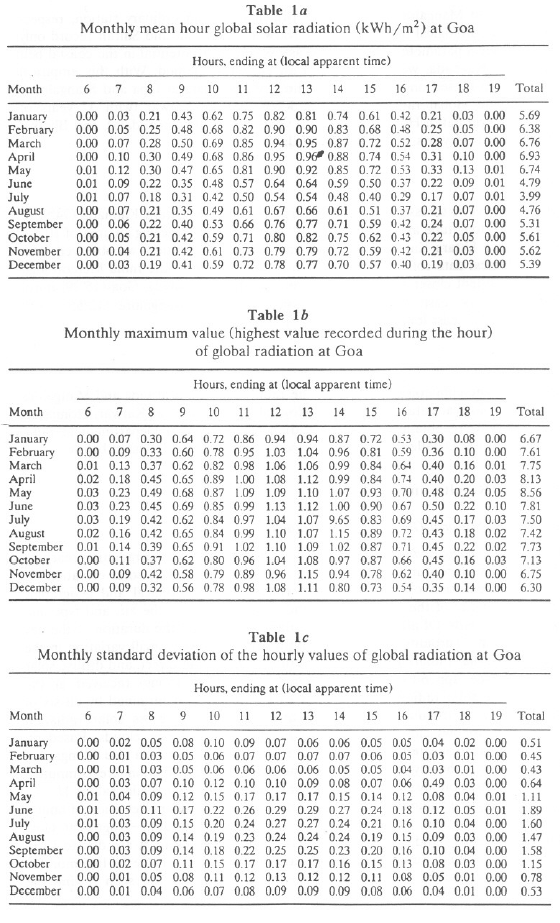
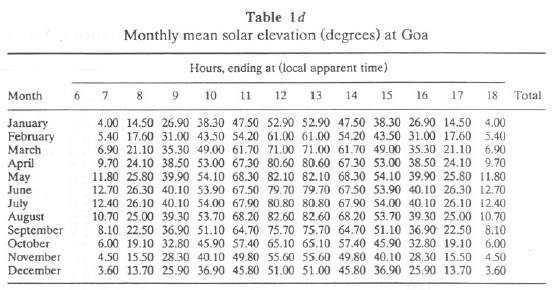
May-August period. Monthly mean hourly values of direct solar radiation are given in Table 1e, and monthly hourly relative air mass is given in Table 1f. Tables 1g, 1h, and 1i list monthly hourly maximum, average, and standard deviation values of diffuse solar radiation.
The mean values of direct solar radiation were measured at 0830, 1130, 1430, and 1730 Indian Standard Time (IST) with an Angstrom pyreheliometer. The pyreheliometer observations are recorded only when the sun's disc and surrounding sky are free of clouds.
Monthly hourly maximum, mean, and standard deviation values of global radiation for Mangalore are listed in Tables 2a, 2b, and 2c, respectively. Total global radiation ranges from 5.17 (November) to 6.42 (April), while during the monsoon months, it ranges from 3.032 (July) to 4.93 (October). Higher values of standard deviation for the period May-August are due to large day-to-day variability (usually caused by variable cloudiness). Monthly elevation of direct solar radiation for Mangalore is given in Table 2d. Monthly variations in mean hourly global radiation at Goa and Mangalore are illustrated in Figures la and 1b, respectively.
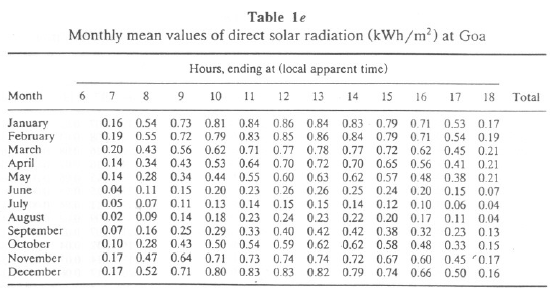

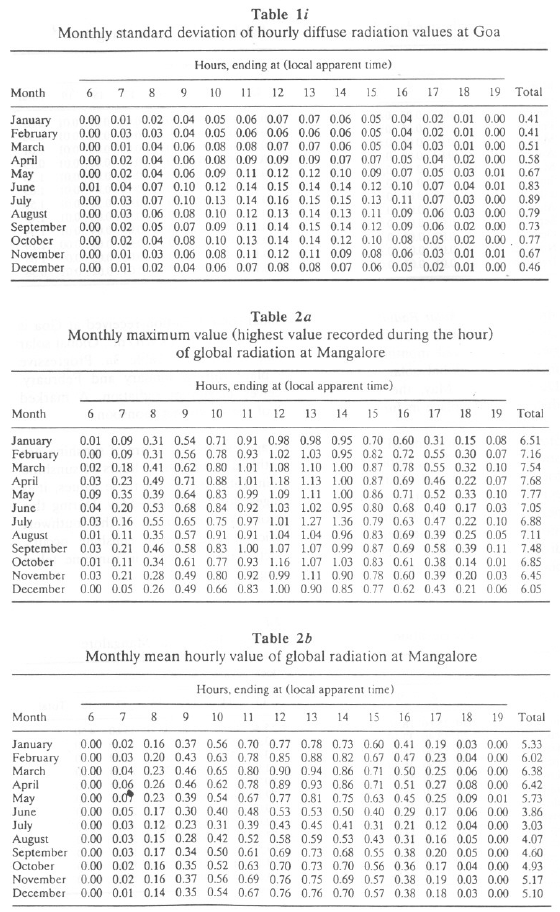
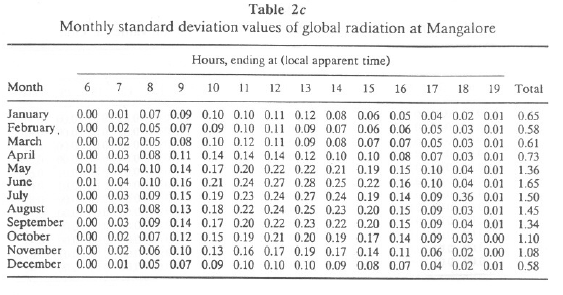
Annual Global Solar Radiation. Annual global solar radiation received at Goa is about 2064.7 kWh/m2, while at Mangalore it is about 1813 kWh/m2. Global solar radiation received monthly at these stations is listed in Table 3a. Progressive increased in global solar radiation takes place during January and February. During March-May, the coastal belt receives maximum radiation. A marked decrease takes place in June with the onset of the southwest monsoon.
Sunshine. At Goa and Mangalore, the average number of hours of sunshine are about 2665 and 2737, respectively. The monthly distribution of hours of sunshine for stations Goa and Mangalore are listed in Table 3b. From these values, it is evident that the duration of sunshine is longest for December-May. During this period, mostly clear sky prevails in the region. With the onset of the southwest monsoon during June-September, a significant reduction in sunshine occurs, dropping to a low of 70-80 hours. From October an increase in sunshine takes place in the coastal belt of Western Ghats region.
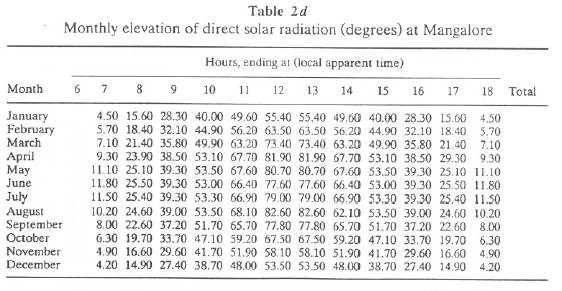
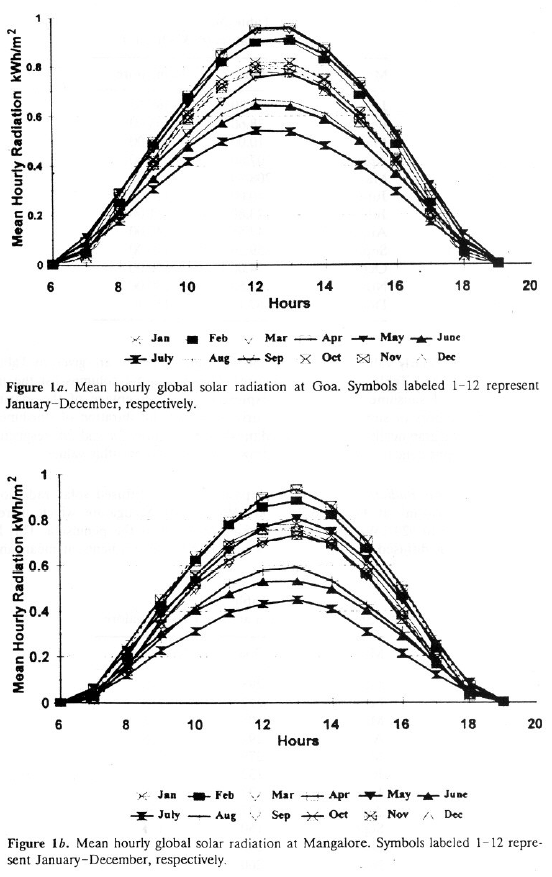
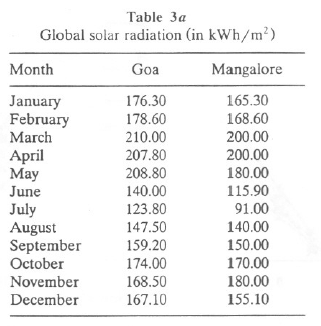
Mean hourly values of the duration of bright sunshine are given in Table 3c (for Goa) and Table 3d (for Mangalore). The daily total columns list the mean duration of sunshine. This is also expressed as a percentage of the maximum possible hours of sunshine. Mean hourly values of the duration of sunshine are illustrated graphically for Goa and Mangalore in Figures 2a and 2b, respectively. Both graphs concur with inferences drawn earlier from monthly values.
Diffuse Solar Radiation. The annual pattern shows diffused solar radiation of 809.90 kWh/m2 at Goa and 850.00 kWh/m2 at Mangalore which increases southward to 920 kWh/m2 in the extreme of south of the peninsula. This large gradient in diffused solar radiation is associated with gradients in mean annual
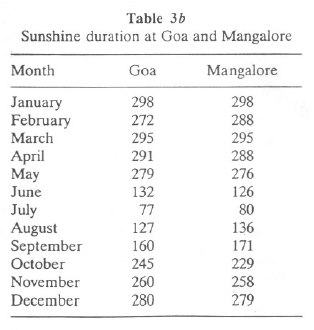
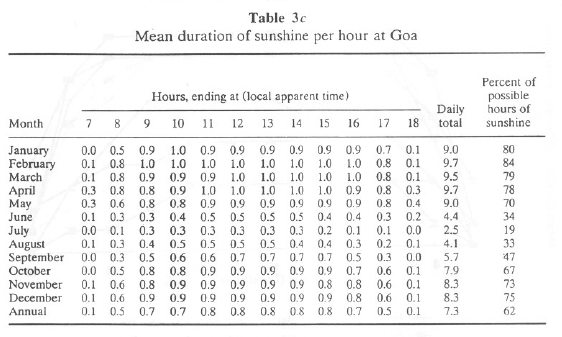
cloudiness. The monthly distribution of diffused solar radiation is given in Table 3e. In December and January, diffused solar radiation is minimum (35-40 kWhjm2). A general increase takes place during June-August as a result of increased cloudiness and the advance of the monsoon. It reaches maximum (100-105 kWh/m2) during August. Mean hourly values of diffuse solar radiation and standard deviation for the hourly values are listed in Table 1a for Goa. It is seen that diffuse radiation is high for the period 1000-1600 hours during May-July.
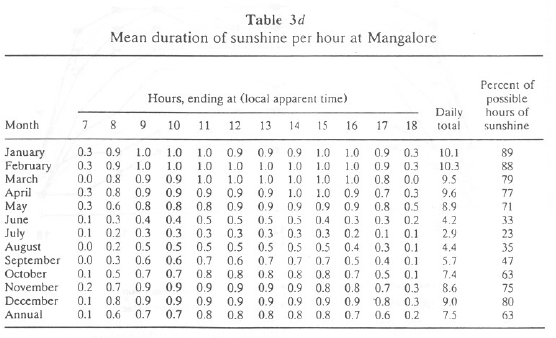

The proportion of diffuse radiation D to global radiation G varies widely, depending on the cloudiness of the sky. The maximum occurs during June-August at these stations and the minimum 20-25% occurs during November-February. During November-February, D/G values undergo characteristic diurnal variation under clear-sky conditions with minimum occurrence during noon and maximum in the morning and evening. Monthly D/G values are listed in Table 3f.

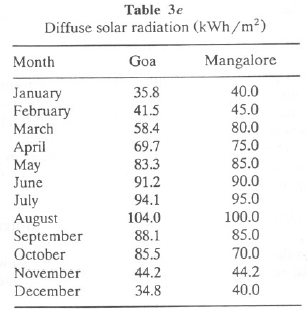
Computation of Global Radiation Procedure. At sites where no radiation data are available, solar radiation is computed using regression techniques from (1) sunshine and cloudiness and (2) extraterrestrial radiation, allowing for its depletion by absorption and scattering in the atmosphere. There is an obvious relationship between duration of sunshine and amount of solar energy received at the earth's surface. Hence earlier researchers like Kimball (1919), Angstrom (1924), and others used sunshine data to derive empirical formulas for solar radiation estimates (Angstrom, 1924, 1956; Tasdemiroglu and Sever, 1989; Page, 1980, 1989; World Meteorological Organization (WMO), 1981). The statistical relationship formulated between the daily duration
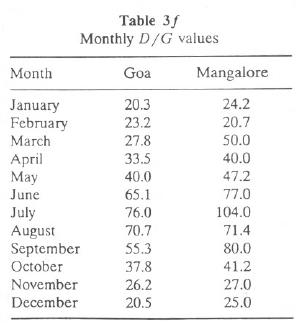
of sunshine n and the daily total global radiation G is of the form
G/Go = a + b(n/N)--------- (1)
where Go is the daily global radiation with a cloud-free atmosphere and N is the maximum possible duration of sunshine. In order to compute n/N at places where only cloud cover data are available without mean sunshine duration data, the inverse relationship between sunshine (n/N) and cloud cover (C) is used, which is given by 1 - n/N = C. Since n/N' (where N' is the maximum possible sunshine with solar elevation > or = 5°, in hours) is used for deriving G (Hoyt, 1977), the relationship between n/N' and C is given by
1 - (n/N') = 1C + 0.310(C2) + 0.476(C3) + 0.100(C4) -----------(2a)
Due to difficulties in the precise evaluation of Go in Eq. (1), Go was later replaced by the extraterrestrial radiation (ETR) on a horizontal surface, and the relationship is
(G/ETR) = a + b(n/N) -------------(2b)
Extraterrestrial radiation on a horizontal surface for any place for any day /month can be precisely estimated from the relationship
ETR(kWh/m2/d) = 10.39k(cos f cos d sin ws + ws sin f sin d) ------------(3)
where 10.39 represents the solar constant (assumed equal to 1.36 kW/m2 multiplied
by 24/p, k is the correction factor for varying earth-sun distance, f is
latitude, d is mean monthly declination, and ws is the sunset hour angle in radians.
Coefficient b in Eq. (2b) expresses the rate of increase of G with increase in
n / N. For a clear sky, n/ N is unity, and thus the parameter (a + b) is the fraction
of ETR that actually reaches the earth's surface. The magnitude of a generally
depends on the thickness of the prevailing clouds, and b depends on the transmission
characteristics of the cloud-free atmosphere. In the analyses of solar radiation
for Canada (Hay, 1979), it was found that the surface albedo plays an important
role in determining the magnitude of G in addition to the multiple reflections
between the ground and the cloud base or the clear atmosphere. Also, the
modified duration of day length N' was considered instead of N, to take into
account the fact that the sunshine recorder sensitized card gets burned only when
the sun is at an elevation of 5° or above the horizon. Hence, instead of N, N' is
computed as below:
N = arccos ( - tan f tan d) /7 .5-----------------(4)
N' = arccos[(cos85 - sin f sin d)/cos f cos d]/7.5----------------- (5)
and the relationship used to estimate global radiation at a site is
G'/ETR = a + b(n/N') -----------------(6)
where G' is the global solar radiation that first strikes the ground before undergoing
multiple reflections with the clear atmosphere and the cloud base. The
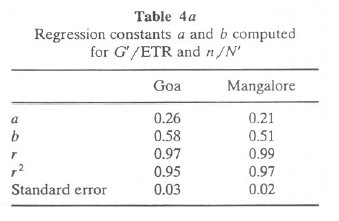
relationship between G and G', assuming albedo of the cloud-free atmosphere as 0.25 and that of the cloud base as 0.60 is given by (Hay, 1979)
G - G' = GR[(0.25n/N') + 0.600 - n/N')] -----------------(7)
where GR is global radiation. This relationship, Eq. (6) is applied to Goa and Mangalore to see how much the observed and calculated values agree for data of Goa and Mangalore. This exercise would help in estimating global radiation at other locations in the Uttara Kannada district, where radiation data are not available. The regression constants a and b computed for G'/ETR and n/ N' are given in Table 4a, while Table 4b gives the calculated and measured values of G for Goa and Mangalore. It is seen that computed and measured values of G agree within the range of 2-5% for most months. This is shown pictorially in Figure 3a.
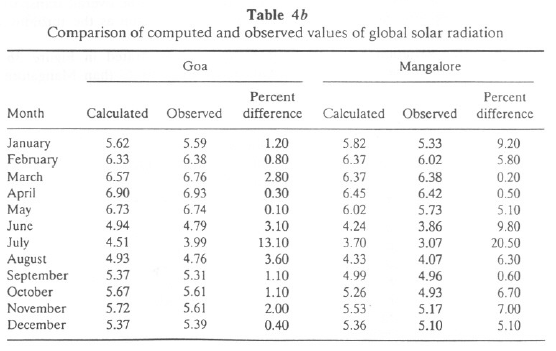

Computation of Diffuse Solar Radiation. As in the case of global solar radiation, diffuse solar radiation is given by (Collares-Pereira and Rabl, 1979)
D'/G' = C + D(G'/ETR)
D is computed by D = D' + GR{[0.25(n/N')] + 0.60[1- (n/N')]}.
The regression constants c and d computed for D'/G' and G'/ETR are given in Table 4c. Based on this relationship, computed diffuse solar radiation and that actually measured at Goa are given in Table 4d. Tables 5a (for Goa) and 5b (for Mangalore) list monthly mean values of G, D, IH (daily sum of direct solar radiation, given by IH = G - D), ETR, N, N', and CI (clearness index = G/ETR). CI gives a good measure of the overall transparency of the atmosphere, taking into account the clouding as well as the turbidity and water vapor content.
Monthly variation of G, D, and IH are also illustrated in Figure 3b for Mangalore and Goa. It is seen that Goa receives higher G than Mangalore for
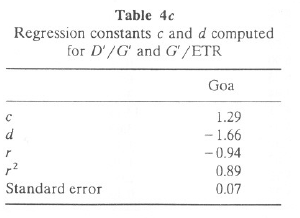
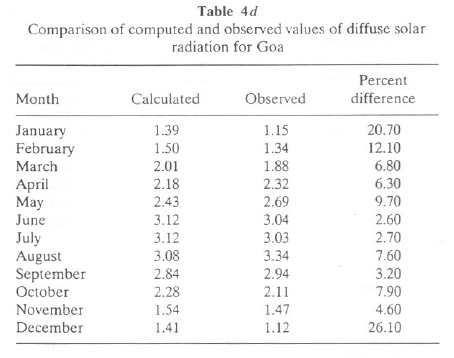
most months. It peaks in April and reaches its lowest value during July. Figure 3c gives monthly variations of ETR, N, and N' for Goa and Mangalore. ETR, N, and N' are higher for Goa than Mangalore for most months. CI is in the range of 0.5-0.7 during October-April, while it is less than 0.5 during the monsoon period (June-August). WS (sunset hour angle), when divided by 7.5, gives duration of the
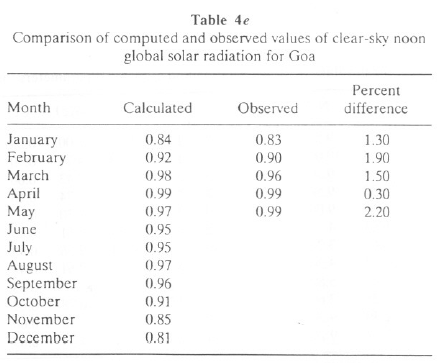
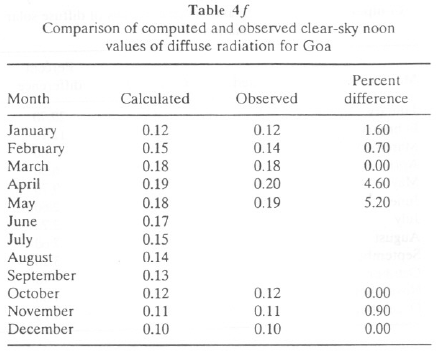
day in hours. Global radiation tilt factors computed for surfaces facing south for various tilt angles of latitude f, f + 15°, f - 15°, 22.5°, and 90° are listed in Tables 5e (for Goa) and 5d (for Mangalore). This is also illustrated in Figure 3d for Goa and Mangalore. The tilt factors help in estimating global radiation on a sloping surface (by multiplying tilt factor with global radiation on horizontal surface).
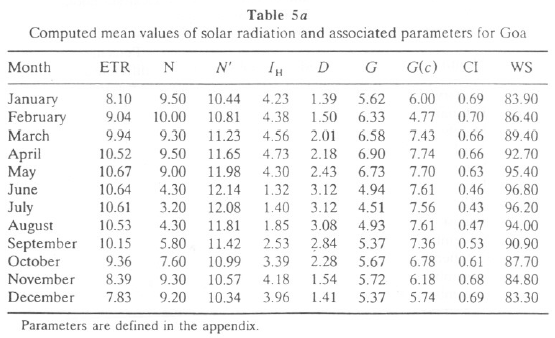
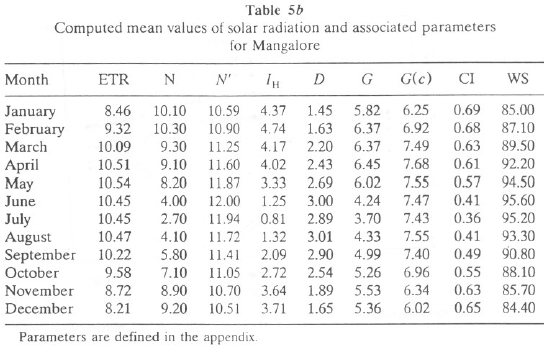
Statistical Analyses of Global Radiation Data at Goa and Mangalore
In order to get a complete picture of the solar radiation distribution, we looked at the median and the frequency distribution. For precise estimation of the degree of departure of a given frequency distribution from a symmetrical one, we used the "skewness" factor. Also, we computed "kurtosis" to determine the distortion in the intermediate ranges between the mean and extreme values. Normal distribution
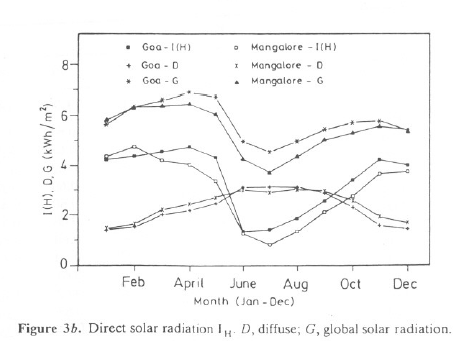
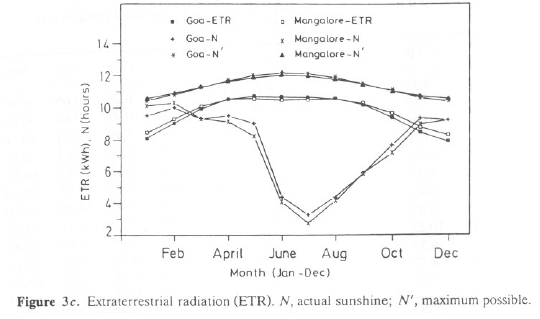
has a kurtosis of 3. The distribution having kurtosis < 3 is called platykurtic, has a broader modal part than the normal curve. Kurtosis > 3 is called leptokurtic, and distribution is more sharply peaked than the normal distribution. Skewness and kurtosis computed for distribution of daily global solar radiation is given by
skewness = (m3/ m2)3/2 kurtosis = (m4/m2)2
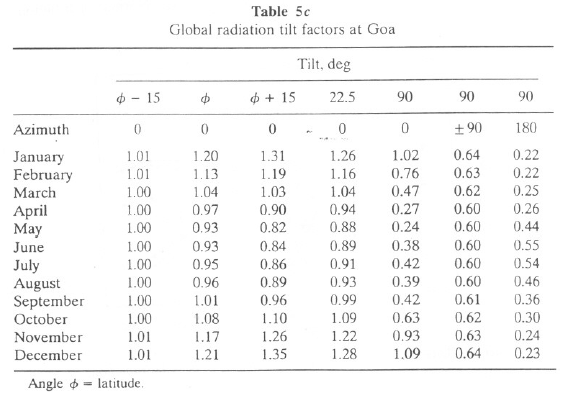
where m2= second moment = (Sxi2) / N, m3= third moment = (Sxi3) / N, m4 = fourth moment = (Sxi4) / N and xi are deviations of the individual values in the series consisting of N items from their arithmetic mean. Skewness and kurtosis computed for each month for Goa and Mangalore are listed in Table 6a. It is seen that global radiation values at Goa for June-September have a broader modal distribution. while November-May with kurtosis > 3
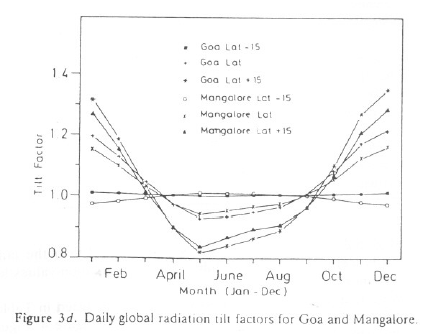
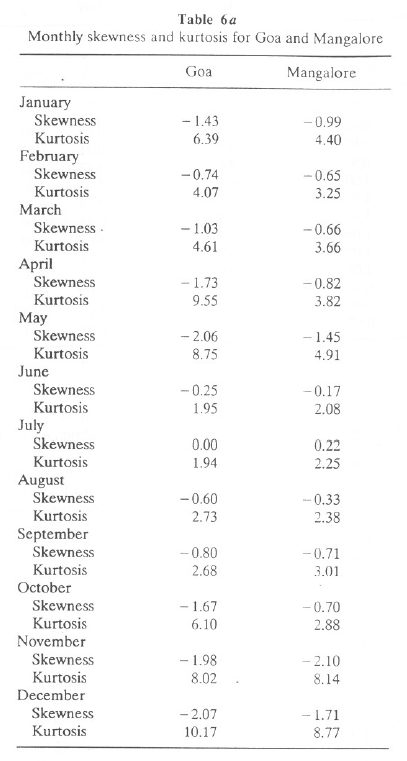
has distribution of global radiation values more sharply peaked than the normal distribution. Also, it is seen that, except for July, the global radiation values lower than the mode occur more frequently at Goa and Mangalore.
Median values of hourly and daily global solar radiation are listed in Table 6b (for Goa) and Table 6c (for Mangalore) and are illustrated in Figure 4. Figure 4 shows that the median values of hourly global radiation are higher during
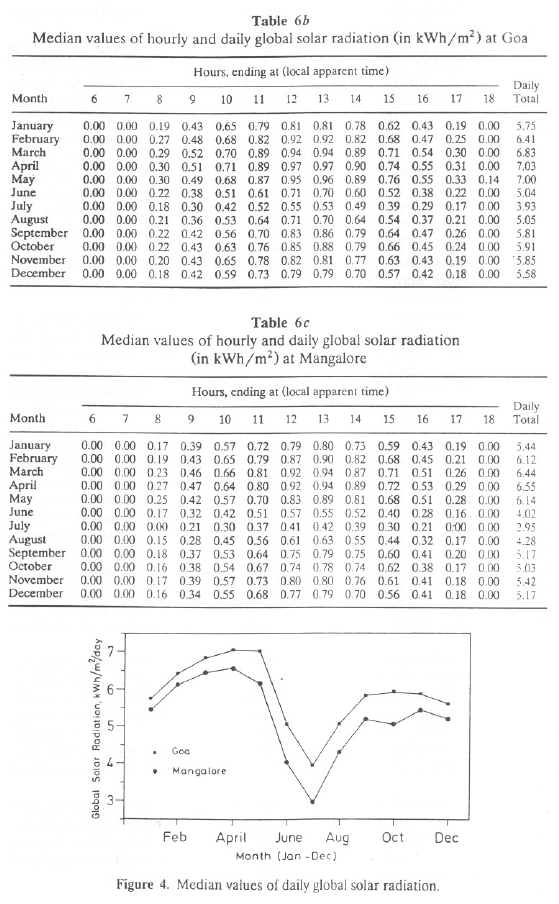
March-May for Goa and Mangalore. It appears from Figure 4 that Goa has higher median values of hourly global solar radiation for all months.
The monthly percentage frequency distributions of global solar radiation at Goa and Mangalore are given in Tables 6d and 6e. This range gives an idea of maximum solar radiation possible in a month and the design of proper backup devices to store the energy for the lean period requirement in a day. Tables 6a and 6b also list cumulative frequency distribution of solar radiation in the range 0-9 kWh/m2/d in steps of 0.5. It is seen that percentage of occurrence in the interval 5.5-7 kWh/m2/d is more during November-May (65-85%) for Goa and Mangalore. For June-August the percentage of occurrence is 55-70% in the range 2.5-5.5 kWh/m2/d.
The cumulative percentage frequency distribution of daily global solar radiation is illustrated for the periods December-May and June-November for Goa in Figures 5a and 5b, respectively, and Mangalore in Figures 6a and 6b. These illustrations confirm our earlier conclusions that Goa and Mangalore receive global solar radiation in the range 5.5-7.5 kWh/m2/d during November-May. During June-August and September-October the solar radiation received is in the ranges 2.5-5 and 3.5-6.5 kWh/m2/d. These analyses show that solar potential at Goa and Mangalore is in the range 5-7 kWh/m2/d for about 9 months a year and 3.5-5 kWh/m2/d during the monsoon season. Dense cloud cover for about 10-12 days on average in July and 5-6 days in August are the lean periods for solar energy in this region. With these detailed investigations of daily global solar radiation data collected at Goa and Mangalore, we attempted to assess the solar potential in the Uttara Kannada district. Uttara Kannada consists of three distinct zones, namely, the coastal belt (consisting of the five taluks Karwar, Ankola, Kumta, Honnavar, and Bhatkal), the Sahyadrian interior (consisting of the five taluks Supa, Yellapur, Sirsi, Siddapur, and part of Haliyal), and the plains area (consisting of the taluks Mundgod and part of Haliyal).
Radiation stations at Goa and Mangalore are also in the coastal belt of the Western Ghats region and are located adjacent to Uttara Kannada (Goa is to the north and Mangalore is to the south of Uttara Kannada). The coastal line, covering a distance of 114 km, stretches from Machale near Karwar to Gorte near Bhatkal. The distance between the Goa radiation station and the Karwar climatological station (moving from north to south) is about 60 km, between Karwar and Honnavar is about 72 km, and between Honnavar and Bhatkal is about 40 km. The Mangalore radiation station is about 120 km from Bhatkal.
Karwar and Honnavar are closest to the Goa radiation station, while Bhatkal is closer to Mangalore. The India Meteorological Department has set up climatological stations at Karwar (l4°47'N latitude, 74°08' longitude, elevation 4 m, established in 1877), Honnavar (l4°17'N latitude, 74°27' longitude, elevation 26 m, established in 1935), and Bhatkal (Shirali 04°05'N latitude, 74°32' longitude, elevation 45 m, established in 1974)), where observations are made at least once per day, including daily readings of extreme temperatures and of amount of precipitation.
The computations of daily sums of global radiations at Karwar, Honnavar, and Bhatkal (Shirali) are carried out mainly by using regression relations between solar radiation and sunshine duration. These regression relations derived from 25 years of data collected at Goa and 20 years at Mangalore. It is found that computed values of solar radiation agree within 5-10% of the observed values.
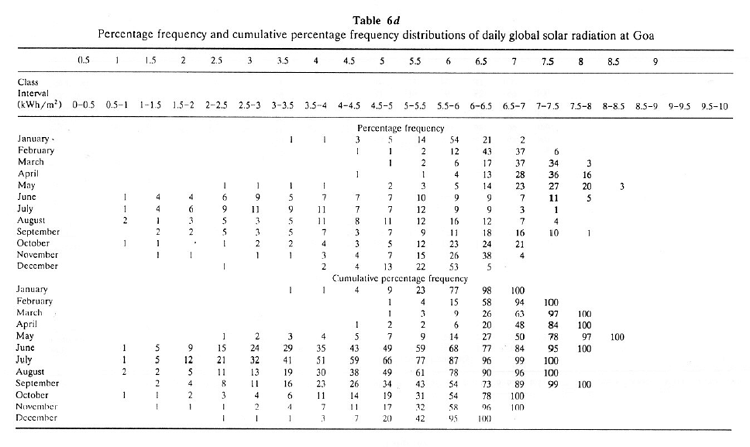
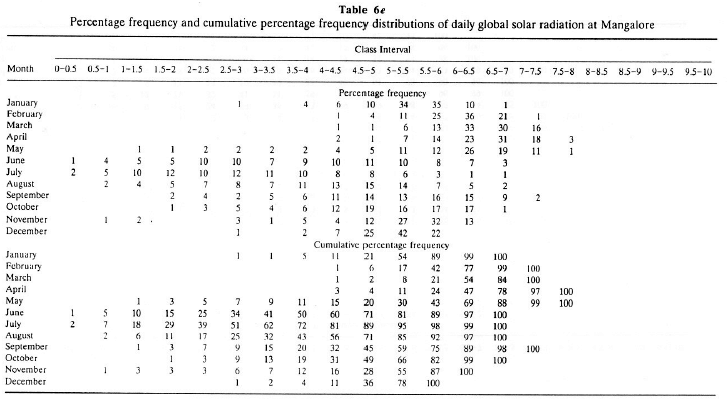
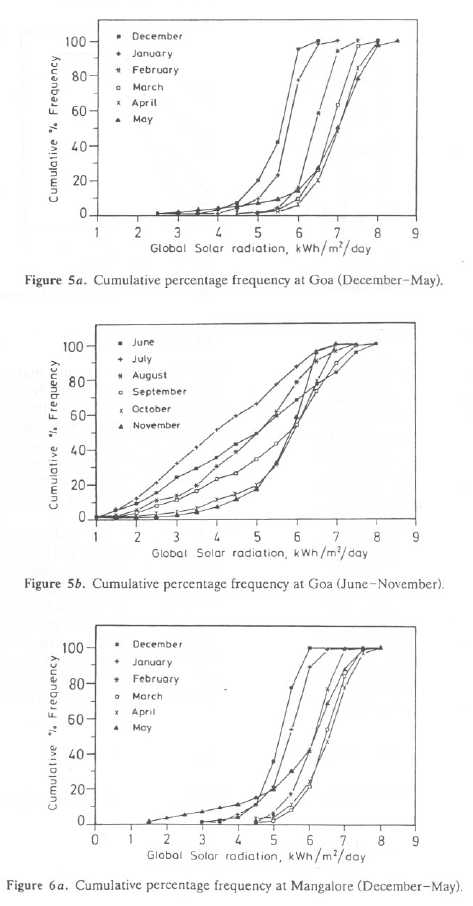
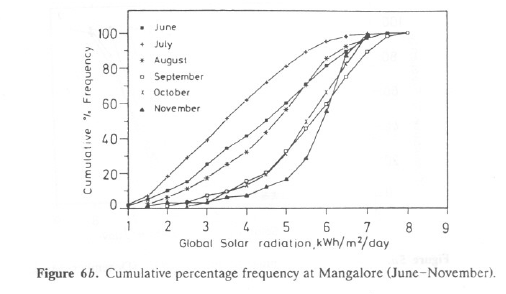
Estimation of Solar Energy in the Coastal Belt of Uttara Kannada
Data for hours of sunshine mean temperature, minimum and maximum daily temperature, relative humidity, and total rainfall, all as monthly averages for Karwar (for the period of 1952-1989), Honnavar (for the period 1939-1989), and Shirali (for the period 1974-1989) provided by the India Meteorological Department (at Pune), have been analyzed and used to estimate solar radiation in the coastal belt of Uttara Kannada. With the knowledge of the regression relation between global radiation and sunshine hours at Goa and Mangalore (which agrees with observed values within 2-5%), we interpolate to determine global radiation in the coastal belt of Uttara Kannada.
Radiation data for Mangalore for the period 1963-1983 and for Goa for the period 1963-1988 obtained from the Indian Meteorological Department and Handbook of Solar Radiation of the Department of Science and Technology, Government of India (Mani, 1980; Mani & Rangarajan, 1982), show the relation between G (global radiation) and hours of sunshine (Eqs. (6) and (7) above).
In addition, in the following section, we try to investigate the influence on global radiation of other climatological parameters such as mean temperature Tm, relative humidity RH, specific humidity SH, rainfall R, and ratio of minimum and maximum temperature Y in terms of either a single parameter or multiparameters. SH is used instead of RH to take care of the relatively large variations in RH (Garg & Garg, 1982) and is given by
SH = RH(4.7923 + 0.3647Tm + 0.55Tm2 + 0.0003Tm3)
The different relations obtained considering various climatological parameters are as follows:
G'/ETR = a + b(n/N') ---------------(6' )
G'/ETR = c1 + c2(n/N') + c3Tm ---------------(8)
G'/ETR = d1 + d2(n/N') + d3Y ---------------(9)
G'/ETR = e1 + e2(n/N') + e3Y+ e4SH---------------(10)
G'/ETR = f1 + f2(n/N') + f3Tm + f4 SH---------------(11)
G'/ETR = g1 + g2(n/N') + g3Tm + g4 RH---------------
(12)
G'/ETR = h1 + h2(n/N') + h3Tm + h4 SH + h5 R---------------(13)
G'/ETR = j1 + j2(n/N') + j3Tm + j4 RH + j5R---------------(14)
G'/ETR = k1 + k2(n/N') + k3(n/N')2 ---------------(15)
Tables 7a and 7b list the results of various relations tried for data at Goa and Mangalore. From these tables we found that Eqs. (11) and (13) are most appropriate, as they have the least error of the y estimate compared to other equations. Using these relations and climatological parameters of Karwar, Honnavar, and Bhatkal, we estimate the monthly global radiation received at Karwar, Honnavar, and Bhatkal. Since Karwar and Honnavar are close to Goa, we estimated their values based on the relation derived at Goa. For Bhatkal, we used the relation derived for Mangalore (since Bhatkal is closer to Mangalore than to Goa). The global solar radiation computed using Eqs. (11) and (13) for Goa and Mangalore is listed in Table 8a. It is seen that the computed and observed values of G agree within +/- 5% for Goa and Mangalore.
The observed and computed values are presented in Figure 7a for Goa and Figure 7b for Mangalore. Estimated values of GR for Karwar, Honnavar, and Bhatkal are listed in Table 8b using Eqs. (11) and (13). The global radiation measured at Goa and Mangalore and computed GR values using Eq. (11) for Karwar, Honnavar, and Bhatkal (Shirali) are given in Figure 8a. Figure 8b presents the same for computed GR using Eq. (13) for Karwar, Honnavar, and Bhatkal (Shirali), which clearly shows that GR undergoes the same seasonal changes as Goa or Mangalore (also the magnitude of GR at these sites falls within that of Goa and Mangalore). Karwar has GR in the range 5.7-6.9 during January-May and in the minimum range of 4-5 during the monsoon months, July-September. At Honnavar the GR range during January-May is 5.47-6.5 kWh/m2 and is minimum during the monsoon months. Thus this study is five locations of the coastal area of the Western Ghats region demonstrates that good solar energy is available in this region during most months. For only a few days in the monsoon months July-August cloud cover in this region was thick and solar radiation was of the order of 3.5-4.5 kWh/m2/d.
Solar Energy Potential Assessments in the Coastal Belt of Uttara Kannada In determining a realistic potential for solar energy converting systems, it is quite evident that we have to take into account the availability of solar energy associated with time, such as daily variation due to day and night cycles, seasonal change due to the earth's orbit around the sun, and variation due to local weather conditions. With the detailed investigation of solar energy availability and changes at various places in the coastal area, we now try to assess the potential that could be harnessed to meet the community energy needs for light, heat, and power in the
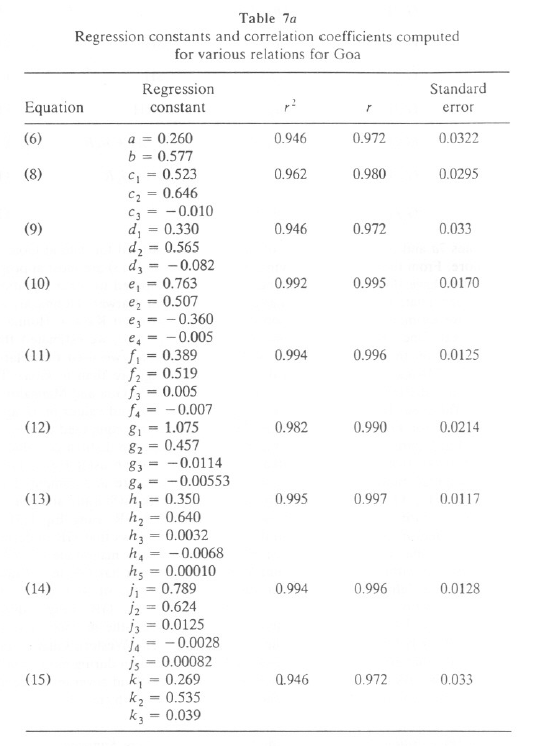
immediate future. Due to the dilute nature of solar energy flux at the earth's surface, large collecting efforts are required in many applications. This makes it necessary to look at land use patterns in a region and at land available for harnessing solar energy. Solar energy systems would be the most interesting option economically if the peak demand for electricity coincides with the highest insolation level.

With an integrated system of solar/wood based/fossil fuel (backup), peak power requirements during the evening hour could be supplied by other sources. Solar and conventional power plants are, to a large extent, based on the same principles. Numerous components identical to both systems may be integrated in one solar/wood/fossil hybrid. In this way, the total investment is
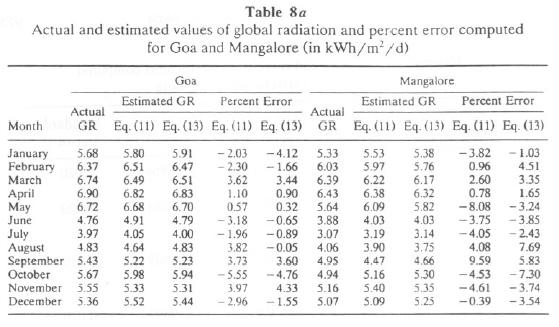
significantly reduced over that required for two single plants. The hybrid system may be optimized for maximum power increase by the solar part of the system by using solar boosters if the peak load is expected in the afternoon hours. Apart from this, there are options like storage batteries (not a solution for more than a few hours), pumped storage hydro backup (location specific), and production of hydrogen through electrolysis of water (rather poor efficiency of 50% or less for the production of hydrogen and reconversion to electricity).
The coastal belt in Uttara Kannada is densely populated, and human influence on forests is quite evident from the barren hilltops (due to deforestation) in this area. Table 9a lists barren uncultivable wasteland by taluk. This varies from 3.34%
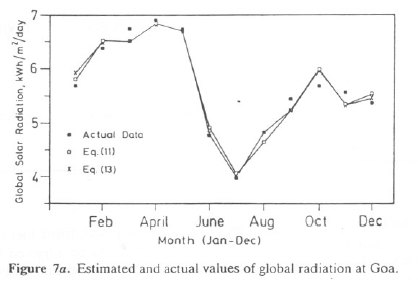
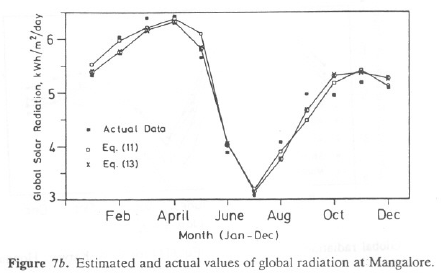
of total geographic area (Bhatkal) to maximum of 8.86% for Ankola. For the purpose of installing solar devices to harness solar energy in this belt, we assume that 1-5% of present wasteland/barren land could be made available. With the assumption that 5% of the present wasteland in each taluk could conveniently be used for harnessing solar energy, we have computed monthly solar energy per taluk that could be harnessed either through photovoltaic or solar thermal power stations. Table 9b lists the amount of solar energy harnessed by utilizing 5% of present wastelands as solar collector areas. It is found that we can generate the

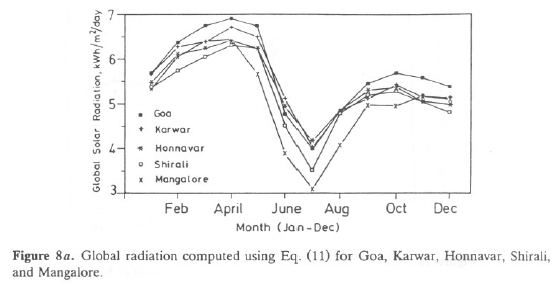
order of 95.72 million units (mkWh) annually from the coastal belt (40.90 mkWh/yr at Karwar, 21.98 mkWh at Ankola, 22.60 mkWh at Kumta, 4.176 mkWh at Honnavar, and 6.045 mkWh/yr at Bhatkal. Table 9c shows that by utilizing 1% of available wasteland in the respective taluks of coastal Uttara Kannada, we can harness 19.14 mkWh/yr.
Annual electricity consumption in Uttara Kannada from various sectors is about 294.049 mkWh. By utilizing 5% of currently available wasteland in the coastal area for harnessing solar energy, at least 32.55% of the present demand of electricity could be met by the solar option.
Solar thermal systems and photovoltaic systems are two fundamentally different concepts of solar energy conversion. For solar thermal conversion, a heat-carrying medium (usually liquid or gas) flows continuously through a heat receiver, thus
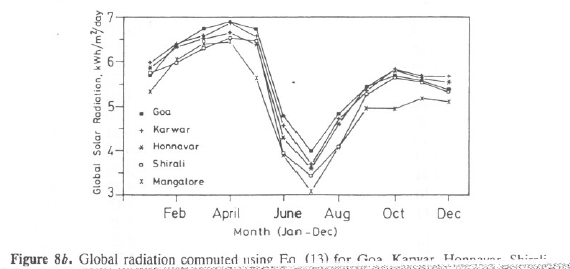
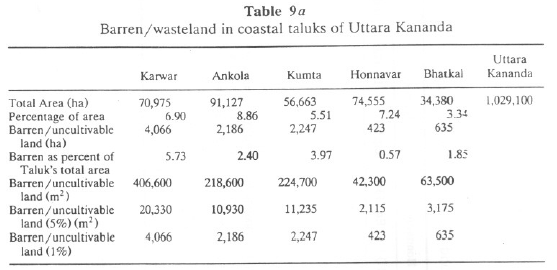
transporting the absorbed heat to the site of thermal use for generation of electricity in a conventional bottoming steam cycle. While photovoltaic systems employ semiconducting compounds having characteristics of the energy threshold and contribute directly to the electricity. The conversion efficiency is independent of system capacity and incoming radiation intensity. As a consequence, a modular design from a few watts to the megawatt scale becomes possible without significant loss in performance even in the case of only moderate insolation. Different solar concepts and possible applications are listed in Table 10a.
Solar Thermal Electric Devices
Parabolic trough, parabolic dish, and central receiver are the three main types of solar thermal electric technologies. Among these, the most advanced type of the "Concentrator" systems is the parabolic trough (De Laquill et aI., 1993). Parabolic troughs track the sun along one axis, concentrating the energy into a receiver tube located at the trough's focal line. Concentration ratios of 10-100 are typically achieved, with operating temperatures of about 400°c. The receiver tube usually has water or oil running through it as the heat transfer medium. This fluid is then piped from each of the parabolic troughs to a central area, where the energy is converted to electricity.
The parabolic dish operates on the same principle as the parabolic trough, but it tracks the sun on two axes, concentrating the energy at the focal point of the dish because it is always pointed at the sun. The concentration ratios of the parabolic dish are considerably higher than the trough of the order of 600-2000, and the operating temperature exceeds 1500°c. The power generating equipment for use with parabolic dishes may be mounted at the focal point of the dish itself, or as with the trough, energy may be collected from a number of separate installations and converted to electricity at a central point. The fomer option is perhaps the most promising use of the dish technology, making it very well suited to remote or stand-alone applications.
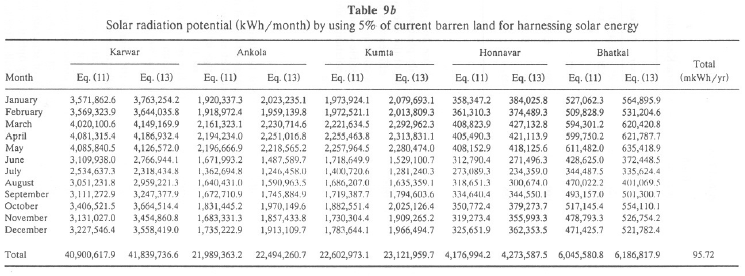
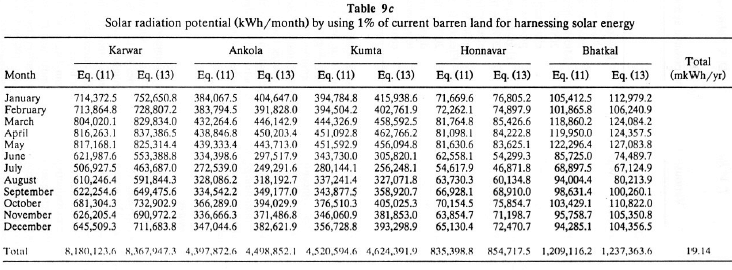
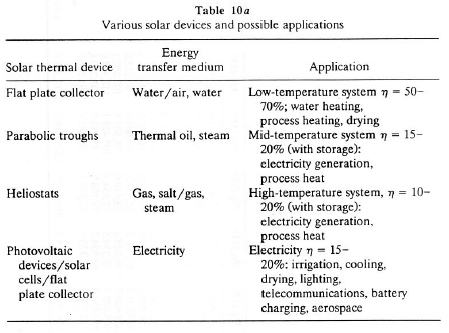
The central receiver is a very promising technology for large-scale grid-connected power generation, even though it is at an early stage of development compared with the parabolic trough technology. In this case, heliostats, flat tracking mirrors, concentrate the sun's energy onto a central receiver tower. Concentration ratios are 300-1500, and systems can operate at temperatures of 500-1500°c. Energy losses from thermal energy transport are minimized as solar energy is being directly transferred by reflection from the heliostats to a single receiver rather than being moved through a transfer medium from several receivers to one central point, as with parabolic troughs. Solar to electric efficiencies for test systems are in the range 10-15%.
Photovoltaic Devices
Photovoltaic (PV) modules are made from a number of materials and fabricated in a variety of different designs. The principle is the same for silicon and other semiconductor devices. When sunlight shines on these materials, it frees electrons from fixed sites. The wavelength of the sunlight absorbed depends on the band gap of the material. The materials are designed so that the electrons cannot return to these sites easily except by flowing through an external circuit, thus generating a current. A typical solar cell consists of a layer of semiconductor material sandwiched between conducting top and bottom layers. PV modules are made up of several interconnecting solar cells, as the individual PV cells do not provide much power. PV modules are generally less than 1 m2 in size and deliver between 50 and 150 W of electric power (Thornton & Brown, 1992). The whole is encapsulated in clear waterproof form arrays, either non tracking or tracking. The latter is complex and more expensive but can optimize the system performance. The efficiency of single-crystal silicon modules is about 10-15%, while that of amorphous silicon modules is about 3-5%. However, the manufacturing cost of the latter is much lower.
Cost of Electricity Generation from Solar Thermal Electric Technologies
The annual capital cost (AC) is computed assuming r = 0.10 and a lifetime t = 30 years and is given by
AC = Cr(1 + r)n/ (1 +r)n -1
Cost of electricity = (AC = O & M)/ E
where E is the number of units of kWh produced annually (kWh/yr).
The cost is computed from the quoted capital cost, assuming 2% of capital cost as operation and maintenance (O & M) cost, and the life of the plant as 30 years. The levelized cost or annual capital recovery factor is computed assuming a discount rate of 10%. The cost computed for solar thermal devices for various load factors and efficiencies are listed in Table l0b.
Solar Energy for Water Heating
Solar energy for water heating would decrease fuelwood consumption in the domestic sector. A survey of rural households in Kumta concerning trends in fuelwood consumption in the domestic sector (kg/capital / d) is shown in Table 11a.
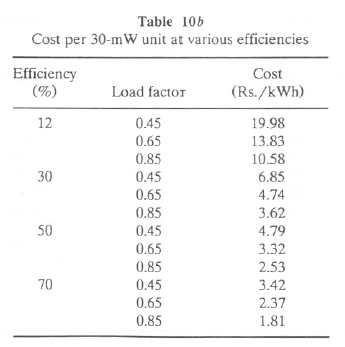

Tables 11b and 11c list population by taluk and seasonal requirements of fuelwood and agricultural residues (converted to fuelwood equivalent) for water heating and cooking. It is seen, on average, that the coastal belt of Uttara Kannada requires 222.56 kilotonnes of fuelwood for water heating and 185.81 kilotonnes of fuelwood for cooking. A fuelwood survey conducted in the villages of Kumta revealed that about 46.7% of the population take a bath everyday, 32.45% take a
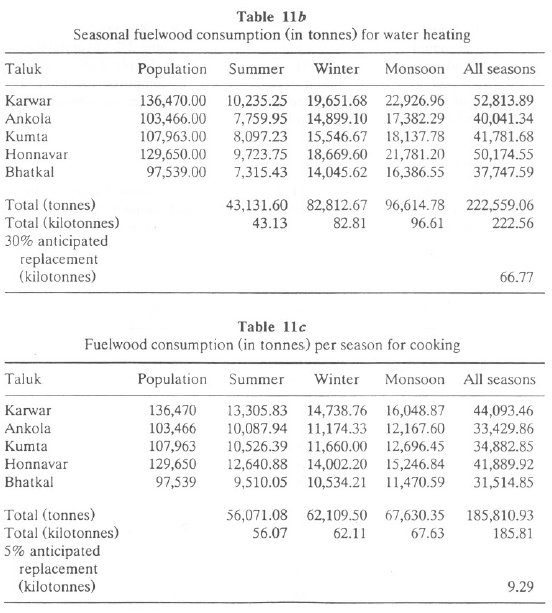
bath twice a day during the agricultural season, 32% once every 2-3 days, 12% once every 4 days, and 9.3% once a week.
Solar water heating technology has been well established and functioning satisfactorily in some places in Bangalore for the past 10 years. An integrated solar system with electric immersion heater is satisfactorily supplying the energy needs for all periods and seasons of the year. Only during very cloudy days are immersion heaters used. The cost of such devices is about Rs.12,000 for 200-L capacity and Rs.8000 for l00-L capacity. In the coastal area we have seen earlier that the climate is favorable to set up solar water heating devices to meet the requirement of hot water for bathing purposes. If 30% of the population switches over to solar water heating devices, the fuelwood savings would be of the order of 66.77 kilotonnes/yr from five coastal taluks of Uttara Kannada. Lack of knowledge of technology and nonavailability. of proper service/maintenance backup in this region are the main reasons that energy efficient devices and alternative technology are not finding significant usage in the rural energy scene.
Rural industries like cashew processing are major consumers of fuelwood in rural coastal areas of Uttara Kannada. A preliminary survey conducted in the cashew processing industries has revealed that some industries use fuelwood of the order of 4-8 kg for processing a kilogram of cashews (in boilers, dryers, etc.). Also, these industries are seasonal, operating at peak load during the premonsoon period (February-June). It is possible to switch over to solar energy for conditioning, mild roasting, and Broma drying operations (solar energy is also plentiful during this period).
Drying is one of the most important processes in the postharvest handling of agricultural products such as cardamom, pepper, chilies, copra, and arecanut. Drying of agricultural products is an energy intensive process. It is estimated that to remove a kilogram of water, 2.5 MJ of heat energy is required (Malhotra & Imre, 1990), mainly through fuelwood and other bioresidues.
Goa and Mangalore receive global solar radiation in the range of 5.5-7.5 kWh/m2/d during the November-May period. During June-August and September - October the solar radiation received is in the range of 2.5-5.0 and 3.5-6.5 kWh/m2/d. These analyses show that solar potential at Goa and Mangalore is in the range of 5-7 kWh/m2/d for about 9 months a year and 3.5-5 kWh/m2/d during the monsoon season. Dense cloud cover for about 10-12 days, on average, in July and 5-6 days in August are the lean periods for solar energy in this region. Computed global radiation using Eq. (6) (linear relationship between global radiation and sunshine hours) and observed values of global radiation vary within the range 2-7%.
In order to improve accuracy using the available data, we have attempted to estimate global radiation using parameters such as sunshine duration, temperature, relative humidity, specific humidity, and rainfall (25 years of data collected at Goa and 20 years at Mangalore). Based on the high correlation coefficient and minimum standard error of estimate, we conclude that Eqs. (11) and (13) are appropriate. It is found that observed and computed values of solar radiation agree within +or-5% of the observed values. With this experience, we have computed GR at Honnavar, Karwar, and Bhatkal based on climatological data of 50 years at Honnavar, 39 years at Karwar, and 15 years data at Bhatkal (Shirali) using Eqs. (11) and (13).
Karwar has a GR range of 5.5-6.5 during January-May and is in the minimum range of 4-5 during the monsoon months, July-September. While at Honnavar, the GR range during January-May is 5.47-6.5 kWh/m2 and minimum during the monsoon months. Thus this study of the coastal area of the Western Ghats region demonstrates that good solar energy potential is available in this region during most months of the year.
The amount of solar energy that could be harnessed by utilizing 5% of the present wasteland in coastal taluks as solar collection areas is found to be of the order of 95.72 mkWh/yr from coastal belt (40.90 mkWh/yr at Karwar, 21.98 mkWh/yr at Ankola, 22.60 mkWh/yr at Kumta, 4.176 mkWh/yr at Honnavar, and 6.045 mkWh/yr at Bhatkal). This constitutes 32.55% of present electricity demand from various sectors of Uttara Kannada.
The authors are grateful to the India Meteorological Department (IMD), Pune, for providing climatological data. Helpful communication with Dr. C. D. Padmanabhan, Dr. G. L. Mokashi, and Dr. M. I. Ali of IMD is gratefully acknowledged. We thank Dr. Tulsidas, Director, IMD, Bangalore, for providing daily surface data for the recent years for the Karwar, Honnavar, and Shirali meteorological observatories. The financial assistance from the Ministry of Environment and Forests, Government of India for Energy Research, is acknowledged.
We thank Professor N. V. Joshi for useful suggestions.
| APPENDIX |
Radiation Parameters
G, global solar radiation, is the total quantity of shortwave solar radiant energy emitted by the sun's disc as well as that scattered diffusively by the atmosphere and clouds passing through a unit area in the horizontal in units of time. It is also referred to as incoming total shortwave radiation.
D, diffuse solar radiation, is that part of shortwave radiation scattered by the atmosphere reflected diffusely and transmitted by clouds and passing through a unit horizontal area in units of time. This radiation comes from a solid angle of 2P with the exception of the solid angle subtended by the sun's disc.
IH, direct solar radiation on a horizontal surface, is the quantity of solar radiant energy emitted from the solid angle subtended by the visible disc of the sun and passing through a unit area in the horizontal in units of time. This is also called the vertical component of the direct solar radiation.
IH = G - D.
IN, direct solar radiation at normal incidence, is the quantity of shortwave
radiation energy emitted by the solid angle subtended by the visible disc of
the sun and passing through a unit area held normal to the solar beam at
the earth's surface in units of time.
IN = (G - D)/sin (h)
where h is the angle of elevation of the sun.
Mean Daily Radiation and Sunshine Parameters
ETR -extraterrestrial radiation on a horizontal surface for a whole day,
(kWh/km2 )
n -actual sunshine duration during a day (hours)
N -maximum possible duration of sunshine
N' -maximum possible sunshine during a day with solar elevation >=5°
(hours)
G -daily sum of global solar radiation (kWh/m2
D -daily sum of diffuse solar radiation (kWh/m2)
IH -daily sum of direct solar radiation on a horizontal surface (kWh/m2)
G(c) -daily sum of global solar radiation in a clear sky under average
conditions (kWh/m2)
CI -clearness index (= G/ETR) (dimensionless).
WS -sunset hour angle, degrees; when divided by 7.5 gives the duration of
the day (hours)
Clear-Sky Noon RadiaJion Parameters
I - direct solar radiation for clear-sky noon under average conditions
(kW/m2)
IH -direct solar radiation on a horizontal surface under average conditions
(kW/m2)
D -diffuse solar radiation on a horizontal surface under average conditions
(kW/m2)
G -global solar radiation on a horizontal surface under average conditions
(kW/m2)
W -total precipitable water vapor in the atmosphere (g/cm2)
P -barometric pressure at station level (mbar)
Mean Hourly Meteorological Parameters
TM -mean hourly temperature, °C
RH -mean hourly relative humidity, percent
W -mean wind speed for certain specified synoptic hours ranging from 1 to 6
in a day, km/h
R -mean total rainfall for a day from 0830 IST to 0830 IST next day, mm
SH -specific humidity
Y -ratio of minimum and maximum temperature